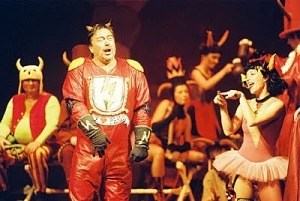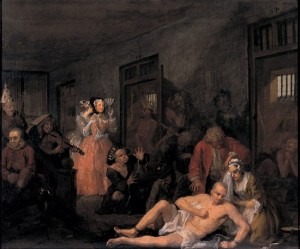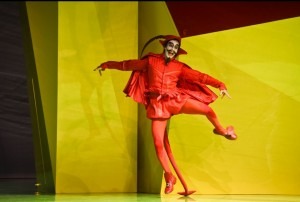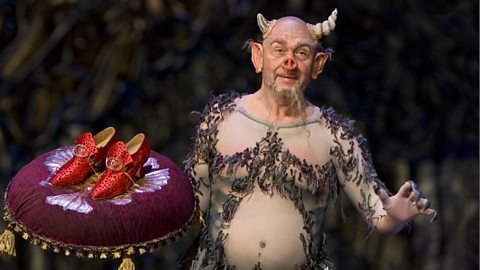
Life in Hell in Čert a Káča in Prague, 2010
Dvořák: Kate and the Devil: Act I: Je sic to trochu daleko (Marbuel, Kathe, Chorus, Mother, Jirka) (Peter Mikuláš, Marbuel the devil; Michelle Breedt, – Kathe; Lenka Kucerova, Mother; Peter Straka, Jirka; Cologne Radio Chorus; Prague Chamber Chorus ; Cologne Radio Symphony Orchestra ; Gerd Albrecht, cond.)

Hogarth: The Rake’s Progress 8: The Rake in Bedlam, 1734 (Sir John Soane’s Museum, London)
Smetana: Čertova stěna: Jen Jediana (Mariusz Kwiecien, – Vok; Polish Radio Symphony Orchestra, Warsaw; Łukasz Borowicz, cond.)
Giacomo Meyerbeer’s Robert le diable (Robert the Devil) started the whole idea of grand opera: a melodramatic plot, the leading singers of the day, and, above all, sensational stage effects. Robert’s mother is supposed to have married a devil, hence the son’s name. After an inordinately complicated story, Robert marries his sweetheart at the end, having discovered in the meantime that his best friend, Bertram, is actually his devilish father.
At the end, Bertram is trying to get Robert to sign a document that will damn him for eternity. He fails and returns whence he came while Robert marries Alice.
Meyerbeer: Robert le diable: Act V Scene 3: Mon fils, ma tendresse assidue (Robert, Bertram, Alice) (Warren Mok, Robert le diable; Annalisa Raspagliosi, Alice; Giorgio Surian, Bertram; Bratislava Chamber Choire; Orchestra International d’Italia; Renato Palumbo, cond.)

The Devil in Der Freischütz, Zurich Opera 2016. Photo by Hans Jörg Michel.
Stravinsky’s devil, named Nick Shadow, beguiles Tom Rakewell, who squanders his family money as he seeks to rise in society. Anne Truelove, Tom’s lover who has been cast aside, saves him from losing his soul to Nick, who sinks through the ground whence he came, condemning Tom to eternal madness, and he dies in Bedlam.
Stravinsky: The Rake’s Progress: Act III Scene 2: I burn, I burn! I freeze! (Shadow) (Bryn Terfel, Nick Shadow; London Symphony Orchestra; John Eliot Gardiner, cond.)
We’ll close with one last devil opera, although it certainly isn’t the end of devil in opera!. Carl Maria von Weber’s opera Der Freischütz (The Marksman), made its reputation on the Wolf’s Glen scene. This forms the core of the second act. Our hero, Max, has gone off with Casper to cast some magic bullets to guarantee his win in the morning. Little does Max know that Casper has other plans: the bullets will hit anything the shooter wants, but what Casper wants is for Max to shoot Agathe, his fiancée, otherwise Casper’s soul will be taken by the Devil. Agathe’s bridal wreath deflects the bullet and Caspar loses as Max agrees to be a hermit for a year to earn back an Agathe’s love.
The Wolf’s Glen scene starts with a summoning of the devil Samiel and ends with the casting of the seven magic bullets. The violins provide a suitable commentary on it all.
Weber: Der Freischütz: Act II: Milch des Mondes fiel aufs Kraut (Ekkehard Wlaschiha, Caspar; Francisco Araiza, Max; Will Quadflieg, narrator; Leipzig Radio Choir; Dresden Staatskapelle; Colin Davis, cond.)
It’s clear from all the examples: messing with the Devil is a bad thing. Our heroes die, go mad, regret their decisions, and it’s only Kate who bests the devil in her encounter. We’ll close with another successful Devil conqueror, where good old American country music beats out the devil’s rock and roll.
Charlie Daniels Band: The Devil Went Down to Georgia, 1979


